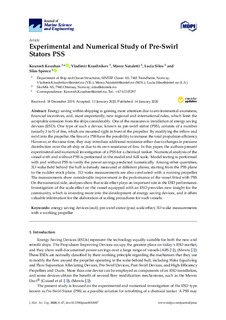| dc.contributor.author | Koushan, Kourosh | |
| dc.contributor.author | Krasilnikov, Vladimir | |
| dc.contributor.author | Nataletti, Marco | |
| dc.contributor.author | Sileo, Lucia | |
| dc.contributor.author | Spence, Silas John Byron | |
| dc.date.accessioned | 2020-02-06T13:48:18Z | |
| dc.date.available | 2020-02-06T13:48:18Z | |
| dc.date.created | 2020-01-30T15:08:54Z | |
| dc.date.issued | 2020-01-16 | |
| dc.identifier.issn | 2077-1312 | |
| dc.identifier.uri | http://hdl.handle.net/11250/2640080 | |
| dc.description.abstract | Energy saving within shipping is gaining more attention due to environmental awareness, financial incentives, and, most importantly, new regional and international rules, which limit the acceptable emission from the ships considerably. One of the measures is installation of energy saving devices (ESD). One type of such a device, known as pre-swirl stator (PSS), consists of a number (usually 3 to 5) of fins, which are mounted right in front of the propeller. By modifying the inflow and swirl into the propeller, the fins of a PSS have the possibility to increase the total propulsion efficiency. However, at the same time, they may introduce additional resistance either due to changes in pressure distribution over the aft ship or due to its own resistance of fins. In this paper, the authors present experimental and numerical investigation of a PSS for a chemical tanker. Numerical analysis of the vessel with and without PSS is performed in the model and full scale. Model testing is performed with and without PSS to verify the power savings predicted numerically. Among other quantities, 3D wake field behind the hull is densely measured at different planes, starting from the PSS plane to the rudder stock plane. 3D wake measurements are also conducted with a running propeller. The measurements show considerable improvement in the performance of the vessel fitted with PSS. On the numerical side, analyses show that scale effect plays an important role in the ESD performance. Investigation of the scale effect on the vessel equipped with an ESD provides new insight for the community, which is investing more into the development of energy saving devices, and it offers valuable information for the elaboration of scaling procedures for such vessels. | nb_NO |
| dc.language.iso | eng | nb_NO |
| dc.publisher | MDPI AG | nb_NO |
| dc.rights | Navngivelse 4.0 Internasjonal | * |
| dc.rights.uri | http://creativecommons.org/licenses/by/4.0/deed.no | * |
| dc.subject | 3D wake measurements with a working propeller | nb_NO |
| dc.subject | energy saving devices (esd) | nb_NO |
| dc.subject | pre-swirl stator (pss) | nb_NO |
| dc.subject | scale effect | nb_NO |
| dc.title | Experimental and Numerical Study of Pre-Swirl Stators PSS | nb_NO |
| dc.type | Journal article | nb_NO |
| dc.type | Peer reviewed | nb_NO |
| dc.description.version | publishedVersion | nb_NO |
| dc.rights.holder | © 2020 by the authors. Licensee MDPI, Basel, Switzerland. This article is an open access article distributed under the terms and conditions of the Creative Commons Attribution (CC BY) license | nb_NO |
| dc.source.volume | 8 | nb_NO |
| dc.source.journal | Journal of Marine Science and Engineering | nb_NO |
| dc.identifier.doi | 10.3390/jmse8010047 | |
| dc.identifier.cristin | 1786815 | |
| cristin.unitcode | 7566,9,0,0 | |
| cristin.unitname | Skip og havkonstruksjoner | |
| cristin.ispublished | true | |
| cristin.fulltext | original | |
| cristin.qualitycode | 1 | |

